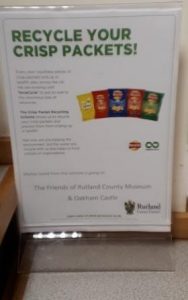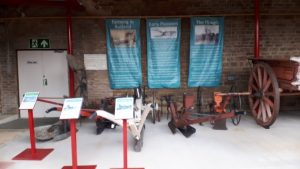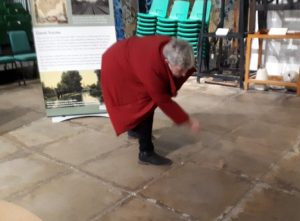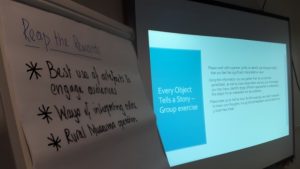As part of the Rural Museums Network Reap the Rewards grant, a series of seminars was organised to promote the RMN, a Specialist Subject Network. This event on 4th February was in Rutland, England’s smallest County, at Rutland County Museum in Oakham.
 Robin Hill was our facilitator for the day and delivered a great example of the sort of friendly expert advice which can be accessed through the Rural Museum Network. As a group we were from a mix of volunteer run, independent, and local authority museums, including one of ‘The Fenland 6’, Leicester Museums Service, and our host Lorraine Cornwell, curator working for Rutland County Council. I was the most distant attendee from Lancashire Museums, but I was keen to learn about Rutland Museum’s Collections Review. With tea and coffee on tap, we each chose an issue with our sites or collections which we would like to disappear. Chatham house rules applied, but as we listened to the issues, helpful suggestions and useful information was provided by Robin and other members of the RMN. My issue, the last mortal remains of a late Medieval / Tudor farmhouse which had been ‘saved’ in the 1970’s but with no paperwork or plans for rebuilding. Robin suggested the Historic Farm Buildings Network as a good source of information and support, and I will be following this up.
Robin Hill was our facilitator for the day and delivered a great example of the sort of friendly expert advice which can be accessed through the Rural Museum Network. As a group we were from a mix of volunteer run, independent, and local authority museums, including one of ‘The Fenland 6’, Leicester Museums Service, and our host Lorraine Cornwell, curator working for Rutland County Council. I was the most distant attendee from Lancashire Museums, but I was keen to learn about Rutland Museum’s Collections Review. With tea and coffee on tap, we each chose an issue with our sites or collections which we would like to disappear. Chatham house rules applied, but as we listened to the issues, helpful suggestions and useful information was provided by Robin and other members of the RMN. My issue, the last mortal remains of a late Medieval / Tudor farmhouse which had been ‘saved’ in the 1970’s but with no paperwork or plans for rebuilding. Robin suggested the Historic Farm Buildings Network as a good source of information and support, and I will be following this up.
 All too often we work in isolation, and this simple exercise really highlighted that networking really works, and just talking is a great support when discussing collections.
All too often we work in isolation, and this simple exercise really highlighted that networking really works, and just talking is a great support when discussing collections.
 Museum relevance was another topic of the day and we discussed various ways of making our collections and sites relevant as key to improving sustainability. We often forget that originally many of our towns were built to serve a rural community. Today that concept has been reversed, and now the rural community serves the urban. Interpreting our rural collections linking them to food poverty, environmental conservation issues and the impacts of the new post-Brexit common agricultural policy, are other ways to make our collections relevant to our audiences. Rutland Museum also links to the community and governance by having Rutland Council’s meetings in the Museum, but the best idea of the day was the recycled crisp packet collection point scheme –which links to local schools.
Museum relevance was another topic of the day and we discussed various ways of making our collections and sites relevant as key to improving sustainability. We often forget that originally many of our towns were built to serve a rural community. Today that concept has been reversed, and now the rural community serves the urban. Interpreting our rural collections linking them to food poverty, environmental conservation issues and the impacts of the new post-Brexit common agricultural policy, are other ways to make our collections relevant to our audiences. Rutland Museum also links to the community and governance by having Rutland Council’s meetings in the Museum, but the best idea of the day was the recycled crisp packet collection point scheme –which links to local schools.
At the end of the morning we toured the Museum and it is well worth a visit. The main building is listed because it was built specially as a fencing school to train cavalry troops for the Napoleonic wars. Today its main display area contains chronological cases of Rutland’s history, combined with highlight pieces such as a complete Massey Harris Reaper Binder and an octagonal game larder.
Though a small museum, Rutland has an enclosed courtyard which has been converted to allow the collection to be displayed outside. It was here that the Rutland Collection Review had focused. The review, which we discussed in the afternoon, concentrated on the large objects with each being scored on 6 criteria to a maximum of 35 points. The criteria were uniqueness, surface condition (originality), provenance, production, interpretation value to collection, and personal view / emotional response. Just hearing how Robin and Lorraine had approached the review gave useful indicators as to how I will look at our large object collection review. Rutland has published its review which can be found here>>
 As a result of the review the displays are great and well interpreted as the photos show, I really liked the hanging banners.
As a result of the review the displays are great and well interpreted as the photos show, I really liked the hanging banners.
Further displays in the workshop area included the only New Drop gallows in the UK. As a painting conservator it was interesting to see a hand operated paint mill where dry pigments were ground into powder and mixed with linseed oil.
 As the day continued we enjoyed a great lunch, brilliant cakes and fresh fruit, and we tried the traditional toys and pursuits of an Edwardian child including spinning tops and, ‘Toad in the Hole’- you will have to visit to find out about that one!
As the day continued we enjoyed a great lunch, brilliant cakes and fresh fruit, and we tried the traditional toys and pursuits of an Edwardian child including spinning tops and, ‘Toad in the Hole’- you will have to visit to find out about that one!
During the afternoon Robin highlighted the work the RMN has undertaken to create the Distributed National Collection – a rural collections’ database of objects held in public and private hands which highlight items of significance. Access to this information, via the Collections Trust is a brilliant resource when assessing our own collections and trying to work out the importance, relevance, and scarcity, of an item. Also assisting in avoiding unnecessary duplication of collections across the country.
 Every Object Tells a Story was the final session of the day. We worked in pairs and reviewed an object to see if we could find other ways of interpreting it for a wider audience. My colleague and I decided on the Euxton Hall gun, designed and built to defend Oakham from Napoleonic invasion. Neither of us were particularly keen on it in military terms but after 30 minutes or so of consideration we thought it had great links to the social history of invasion. We thought that it could better engage audiences by linking back to 1066, and forward to 1940, and should also highlight the importance of local invention and discovery.
Every Object Tells a Story was the final session of the day. We worked in pairs and reviewed an object to see if we could find other ways of interpreting it for a wider audience. My colleague and I decided on the Euxton Hall gun, designed and built to defend Oakham from Napoleonic invasion. Neither of us were particularly keen on it in military terms but after 30 minutes or so of consideration we thought it had great links to the social history of invasion. We thought that it could better engage audiences by linking back to 1066, and forward to 1940, and should also highlight the importance of local invention and discovery.
So what did the day do for me? Using the RMN and its peer experts, and linking to work at MERL and MEAL, I now know there are major resources out there to help. By linking to experts with Jiscmail I am hoping to learn more about Lancashire’s collections and save time in doing research.
https://www.ruralmuseums.org.uk/
https://merl.reading.ac.uk/merl-collections/search-and-browse/databases/
http://eastanglianlife.org.uk/collections/
Heather Davis is an archaeologist, art historian and painting conservator with over 30 years’ experience of local authority museums. She is now the senior museum professional at the Lancashire County Museum Service.
